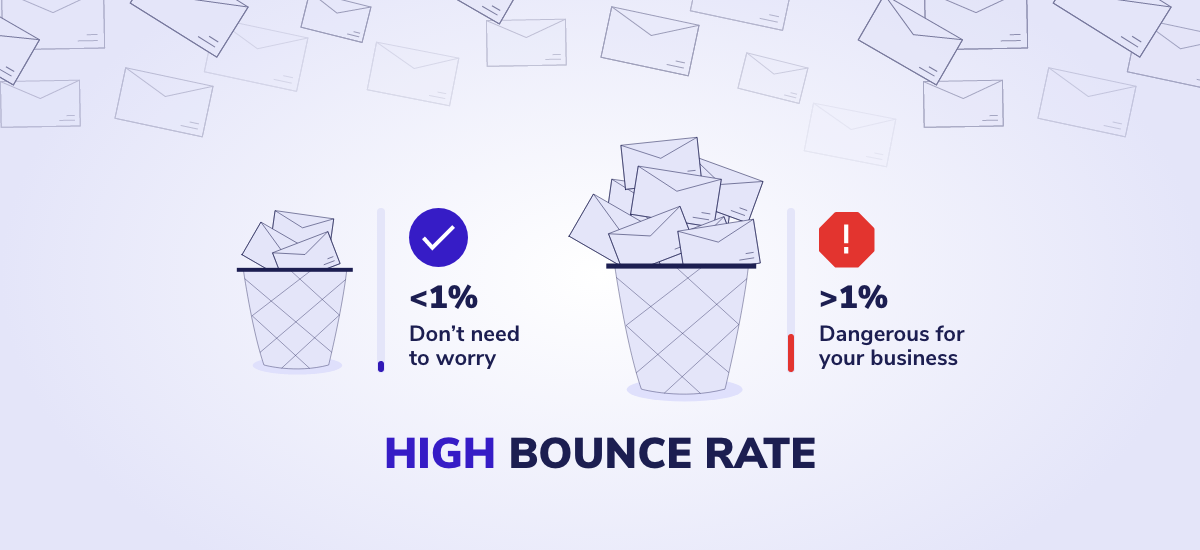Why emails bounce back?
Courses: Email Bounce
Create: 1760 days ago
Update: 1610 days ago
Reading time: 3 min
Technically email bounces are delivery failure notification emails. From the notification email, you can find out the reason for your bounce.
From this lesson, you will learn:
- what delivery failure notification emails and bounce reports are,
- what they mean to your campaign,
- what actions you need to take if you have a high bounce rate.
What is an email bounce back?
Bouncing emails are email delivery failure notifications. Receiving a bounce email means your email wasn’t delivered to the recipient. A high email bounce rate can damage the reputation of your email sending account.
There are several possible reasons for not being able to deliver emails. Some of them are temporary reasons, and some are permanent. To find out why the email has bounced, you need to look at your delivery failure notification email.
Delivery failure notification email

The delivery failure notification email is an email your email sending account is sending yourself, notifying you about your email's unsuccessful delivery. The notification email typically contains your original email as well as the reason for your bounce.
When sending an email campaign, you may experience a higher number of bounces. Hence you cannot analyze your email bounces manually. Therefore, professional email marketing tools generate a bounce report for you.
Bounce report

Bounce reports are supposed to help you identify why your emails have bounced back. A great email marketing tool will provide you with a bounce report containing the following:
- recipient email address,
- category of your bounce: hard bounce or soft,
- the reason for your bounce. Such as "No mailbox" or "
SPF error
 What is email authorization (SPF, DKIM)?
When you start diving into the topic of email marketing, two of the acronyms you'll quickly come across ar...
Read more »
."
What is email authorization (SPF, DKIM)?
When you start diving into the topic of email marketing, two of the acronyms you'll quickly come across ar...
Read more »
."
If your email marketing tool expresses concerns about your high email bounce rate, they must provide you with such a report. Without a bounce report, they cannot expect you to improve the performance of your campaign.
Effects of having a high bounce rate

Having a high email bounce rate
 High Email Bounce Rate Will Kill Your Campaigns
Email marketing tools emphasize the importance of bounce rate for a good reason. A high bounce rate is a c...
Read more »
can severely damage your email campaign's success and damage your email marketing reputation.
High Email Bounce Rate Will Kill Your Campaigns
Email marketing tools emphasize the importance of bounce rate for a good reason. A high bounce rate is a c...
Read more »
can severely damage your email campaign's success and damage your email marketing reputation.
You can expect some bounces. As long as your bounce rate is below 1%, you don't need to worry much about it. Any higher bounce rate is considered dangerous for your business.
Most email marketing tool will suspend or permanently close your account if you have a higher than 4% bounce rate.
Hard and Soft Bounces
The difference between the two is that
hard bounces
 What is a hard bounce?
Hard bounces are permanent email delivery errors that you might experience when sending an email marketing...
Read more »
are permanent, while
soft bounces
What is a hard bounce?
Hard bounces are permanent email delivery errors that you might experience when sending an email marketing...
Read more »
are permanent, while
soft bounces
 What is a soft bounce?
Soft bounces are temporary email delivery errors that you might experience when sending an email marketing...
Read more »
are temporary errors. They both harm your business. You will have an increasing bounce rate, deliver fewer emails, and putting your email reputation at risk.
What is a soft bounce?
Soft bounces are temporary email delivery errors that you might experience when sending an email marketing...
Read more »
are temporary errors. They both harm your business. You will have an increasing bounce rate, deliver fewer emails, and putting your email reputation at risk.
Reduce the bounce rate
To reduce bounce rate, you first need to determine whether you are dealing with hard or soft bounces. You will also need to look into the reasons behind each soft bounce to take the appropriate action.
Conclusion
Hard bounces are permanent. Soft bounces are temporary email delivery errors. Having a high bounce rate will negatively affect your campaign and your business.
You need to keep your bounce rate below 1% before you can focus on other important metrics of your campaigns.
Next Steps
- Understand the difference between the two types of bounces.
- Analyze your bounce report to find the reason for your bounces.




